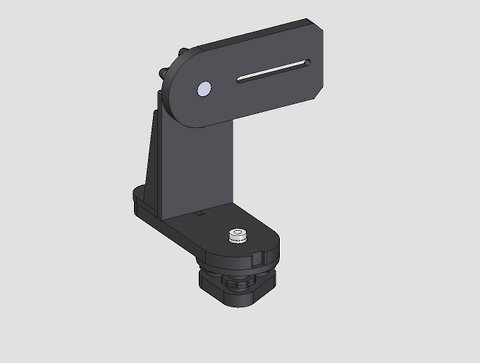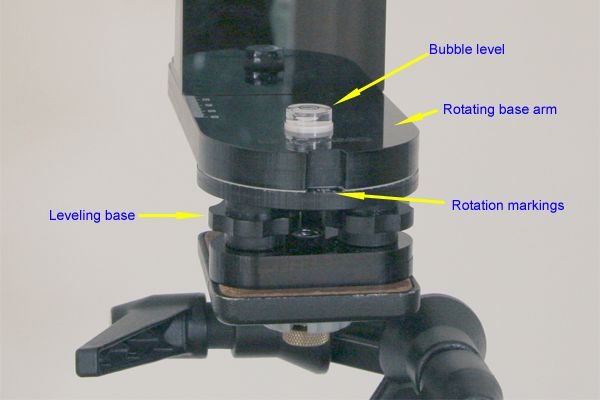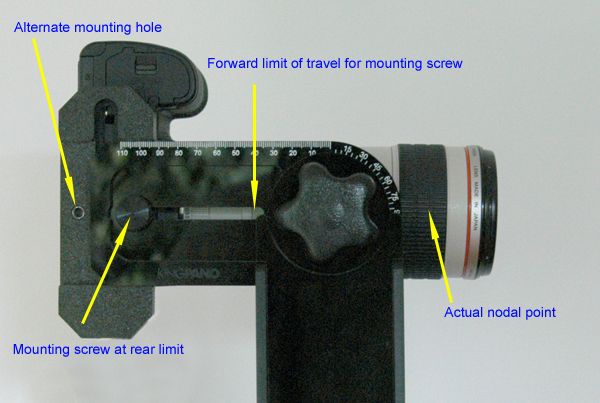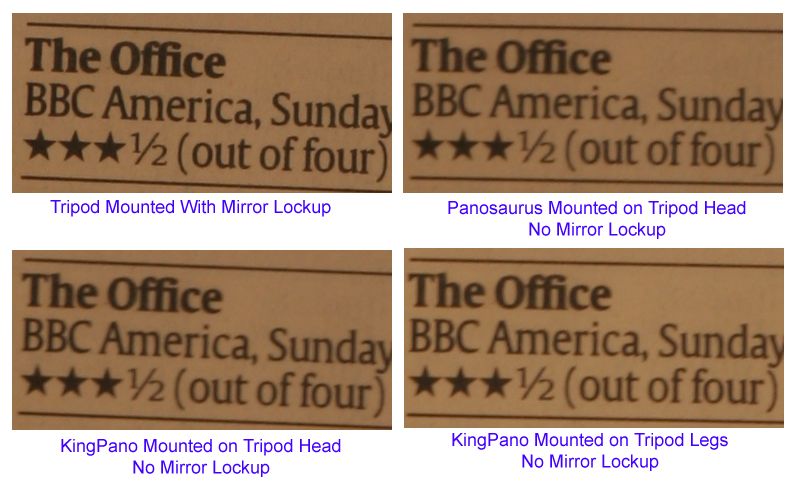|
August 2011 Update. After seeing a number of negative comments about KingPano's
customer service (payment made for products never received) posted in my
discussion forum,
I attempted to contact Bill King to find out if these were true. Like those who have
posted complaints on my forum, I have received no response from Bill, so at this
time I cannot continue to recommend purchasing a KingPano. It is my hope that there
is a simple explanation that will be forthcoming, and if there is, I will update this
page. However, in the meantime, I suggest considering an alternative Pano head.
Introduction. One of the newest entries into the "affordable" (i.e. less than $400) panoramic tripod head market is Bill King's KingPano. Historically, panoramic tripod heads have tended to fall into two categories: (1) heavy, bulky, expensive "professional" models, and (2) home-made, amateur solutions. However, this has started to change, with the advent of new models by small startup companies that offer lighter, cheaper models that are more "professionally" built than most amateur solutions. The KingPano certainly fits this description. Panoramic image stitching is now sufficiently "main stream" that I don't need to go into the standard discussion of what a panoramic tripod head is, why you might need one, and what happens if you don't have one. For that, I encourage you to look elsewhere on this site and drop in to my discussion forums. I assume that if you are reading this review, you are familiar with all of this background. What sets the various heads apart are their less immediately obvious characteristics: how heavy is it? how easy is it to set up? how sturdy is it? and so on. My review will focus on some of the characteristics that I consider to be of interest when evaluating a panoramic tripod head. KingPano website. Before going any further, you might want to take a look at the KingPano website. There are a number of images of the KingPano as well as detailed instructions on how to setup the pano head, and a listing of nodal points for many camera/lens combinations. Construction. The quality of construction was the first thing I noticed about the KingPano. Although many tripod heads are made of metal, the KingPano is made of lightweight acrylic. Bill's website describes it as "cool looking, shiny, and black". I have to say that I agree, particularly the part about it being shiny...You can see yourself reflected in most of the parts of the KingPano. The material feels extremely rigid. Even when exerting considerable force on its base with two hands, I was able to detect only the most minimal flex to the material. But this is something of a torture test...I cannot imagine that it would flex under the weight of a standard camera.
The tripod head has several scales engraved in the acrylic. These scales are bright white and contrast well with the black background. Components. The configuration of the head is similar to other panoramic tripod head designs: One rotating base arm with a 3/8 or 1/4 inch socket (more details below), one vertical arm (Bill calls it a "Horizontal Stabilizer" (HStab)), and a horizontal slider arm (Bill calls this the "Nodal Point Control Arm" (NPCA)). A "Universal Camera Mounting Bracket" (UCMB) mounts onto the base of the camera and attaches to the horizontal slider arm with a thumb screw, allowing for forward/backward motion of the camera to adjust for nodal point positioning. A unique feature of the KingPano is the leveling base that sits beneath the rotating base arm and the tripod to which the KingPano attaches. The leveling base is similar in concept to the Bogen/Manfrotto 3416 Leveling Base. This KingPano's leveling base has three twistable adjusters that can be used to finely tune the level of the KingPano. Because a bubble level is mounted on the rotating base arm, it is very easy to ensure that the KingPano is level when using the leveling base. As far as I know, the leveling base is a feature not found on any of the other models in this price range. The socket in the KingPano leveling base is 3/8 inch, which is a standard size for fitting on most tripod legs. This means that (unlike some of the other low-price panoramic tripod heads) you can mount the KingPano directly onto the tripod legs, rather than having to fit it on top of a standard tripod head. This is a nice touch, and for dedicated panorama shooters allows the use of a tripod without an additional head which (a) cuts down on weight and (b) may increase stability (more below on this topic). However, the KingPano also comes with a 1/4 inch insert which, when screwed into the 3/8 socket, converts its diameter to that of a standard 1/4 socket. When this insert is in place, the KingPano can be mounted directly onto a standard tripod head. This allows for the KingPano to be quickly removed from the tripod head with minimal fuss...very useful if you want to shoot some images with the Panoramic head, and some without.
All things considered, I think the leveling base and mounting choices are an elegant design, allowing for maximum flexibility. If I had to find a quibble it would be that the leveling base, while very nicely designed, is probably superfluous when using the KingPano mounted on top of another tripod head. I haven't measured it, but it adds some (minimal) weight to the overall solution and probably introduces some small amount of additional flex. Not a major problem, to be sure, but something to consider. The rotating base arm has markings that indicate the degree of rotation. The markings are in 15 degree increments, with a 7.5 degree line between each marking. This is probably more than sufficient for most uses, but for those of us who frequently use long focal lenses to produce high resolution mosaics, I would have prefered to see finer increments. To be fair, the finest markings I have seen (on any panoramic tripod head) are in 5 degree increments, but I often find myself wishing for 2 or 2.5 degree increments. The KingPano is shipped in a disassembled state (like other panoramic tripod heads). The three main arms (rotating base, vertical arm, and horizontal arm) are easily assembled using bolts and large thumb screws. No tools are needed, which makes it very easy to disassemble the unit into its component pieces for transport or storage. Dimensions. The unit has approximately the same dimensions as other pano heads in this category (such as the Panosaurus and the Nodal Ninja) although all three of the arms are physically wider than other models I've tested. At 6.5 inches (16.5cm) long, the horizontal arm is 2 inches (5 cm) shorter than the horizontal arm of the Panosaurus, but 1.5 inches (3.8cm) longer than the horizontal arm of the Nodal Ninja. The length of the horizontal arm determines how far backwards the camera can be positioned to accomodate nodal points that are far forward of the tripod mounting socket. Despite its slightly bulky appearance (due to the width of the arms), the KingPano only weighs about 660g (just under 1.5 lbs). This is about 5-10% more than the Nodal Ninja and Panosaurus. Not something you are likely to notice when carrying it around. Field Test. Bill let me test two different versions of the KingPano; the first version had "click stops" built into the rotating base and the second version didn't. The click stops in the first version were every 7.5 degrees. My preference was for the rotating base without the click stops, as I find it easier to use long zoom lenses which require various amounts of rotation. Pretty much any decent panoramic tripod head will allow you to position your camera so that the axis of rotation is in line with the entrance pupil, ensuring the capture of images without parallax. The KingPano is no exception. Most of my lenses worked just fine with the KingPano and I was able to position the camera so that the nodal point was in line with the rotation axis, ensuring parallax-free images. The slot that is cut into the horizontal arm is 3 inches (7.5 cm) long, allowing for a relatively small amount of forwards/backwards adjustment. However, the UCMB can be attached to the horizontal mounting arm using either of two mounting holes drilled into the UCMB, which effectively allows for another 1.25 (3.2cm) inches of travel. (The unused, alternate mounting hole is visible in the photograph below). The KingPano was able to accomodate most of my lenses, although for some of my zoom lenses (e.g. Tamron 28-75 F2.8), I had to take the screw out of UCMB and put it into the other hole as I zoomed from one end of the range to the other. Not impossible, but fiddly...and something I probably wouldn't want to do when standing outdoors at the edge of lake, in the wind, in thick grass, or anywhere else I would regret dropping the small thumbscrew that attaches the UCMB to the horizontal arm. I also noticed that as I positioned the camera close to its most forward point along the horizontal arm, the range of rotation in the up/down direction became restricted. This is because the thumbscrew comes into contact with the vertical arm, and impinges upon the rotation of the horizontal arm. The KingPano also comes with a conventional screw (that requires a screwdriver or coin) that fits inside the slot in the horizontal arm and allows for the full range of motion. In general, I prefer using the thumbscrew so I don't need to use a tool to move the camera when zooming. Quibbles. Before I go any further, I should note that I may be a somewhat atypical user of panoramic tripod heads. First, I use a digital SLR camera (currently a Canon 20D) which is bigger and heavier than the point-n-shoot digicams that are extremely popular currently. Second, while most people are content to use wide or normal lenses when shooting panoramas (e.g. no more than 100mm focal length), I often use long focal length lenses...sometimes as long as 300mm (sometimes with a 2x teleconverter). Obviously, these long lenses tend be heavy and large. Designing a panoramic tripod head to support long lenses would require a much heavier, bulkier, sturdy design, and I wouldn't expect to see a model to accomodate lenses this long in this price range. However, I often use my 70-200mm F4 lens for panoramic images, but have only tested one panoramic head (the Panosaurus) that is able to accomodate it. I was unable to position this lens correctly on the KingPano when the lens is used at its wide end (70mm). The photograph below shows that even with the camera positioned all the way at the end of the horizontal arm (so that half of the UCMB is hanging off the horizontal arm), the nodal point is still not in line with the rotation axis. This is probably irrelevant for most users, as I suspect that I tend to use longer lenses than most others. Still, if you are like me, then this is a concern.
Stability. I was curious to find out if the KingPano performed any better than the other heads I've tested with respect to its stability. I thought that it might because of the width of its arms. I've documented my rationale and methodology for this test elsewhere, so I won't repeat it here. I used a 200mm lens at F8 with a shutter speed of 1/3 for this test. The KingPano put in a decent, but not remarkable, performance compared to the Panosaurus, the most stable other competitor I've tested in this price range. The performance from the KingPano was about the same as from the Panosaurus. I thought that I might see some extra stability when mounting the KingPano directly to the tripod legs, and avoiding any extra flex introduced by my Bogen 3028 tripod head. However, there wasn't any meaningful difference. My conclusion from this observation is that the Bogen 3028 is pretty stable, and doesn't introduce much/any shake into the system. I realized during this test that I might be able to take advantage of the way JPEG compression works to try and quantify the degree of shake in these images. Images with a lot of fine detail don't compress as much as images without fine detail, and so the size of a JPEG file can be used as a fairly good guage of how sharp the image is. Of course, this presupposes perfect autofocus accuracy (not likely!), identical framing, lighting and compression conditions for all images. However, in my testing, there was almost no difference in the file sizes between the images I took with the KingPano and the images I took with the Panosaurus. The performance was essentially identical. However, as expected, the file size for the tripod mounted image was about 15% larger than any of the images I took using the KingPano and Panosaurus.
Bill King. Before concluding, I should say a thanks to Bill King and offer an apology as I've been very guilty about delaying this review. Bill has been more patient than I could reasonably have expected, and been helpful with explanations and even supplied an additional unit for testing after some initial comments. There has been some discussion on my forums about the KingPano and all the comments about dealing with Bill have been very favorable...my experience too! It's nice to see a small company like Bill's that cares about the "little guy"! Conclusion. So what did I think of the KingPano? I liked it. I think that it might be the most "professional" looking affordable pano head that I've seen. The design is elegant, the workmanship appears to be very good with obvious attention to little details. The addition of the leveling base and the ability to mount directly to tripod legs is not matched by other competitors in this class. It is as stable as any other panoramic tripod head that I've tested. Of course, The KingPano costs quite a bit more than some of its competitors ($149 at the time of this review), so one would expect a higher quality product. For me, however, the real test is how well it fits with my type of photography. Unfortunately, the KingPano didn't work too well with one of my favorite lenses which I found quite restricting. And, for some of my other zoom lenses, I had to remove and replace the mounting screw in a different hole as I zoomed the lens from one end to another. To be fair, very few panoramic heads are able to accomodate all cameras without some sort of compromise. And, Bill has even mentioned that he may create a longer horizontal arm at some point in the future. I hope so! Still, if I was a digicam user, or used shorter lenses on my DSLR, this simply would not have been an issue. So, my advice is to check the dimensions of your camera/lens before buying any panoramic head. If it will fit your camera, then the KingPano is well worth a serious look. Contact Information: KingPano web site |



